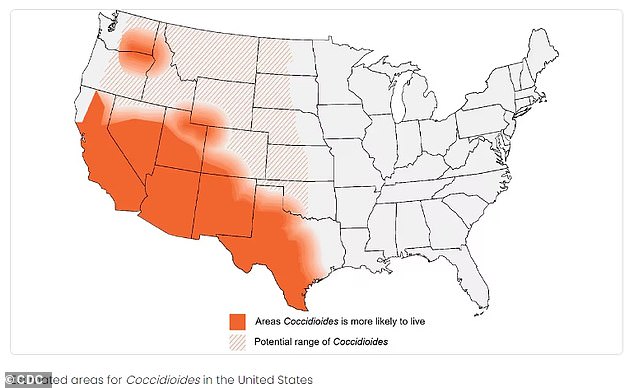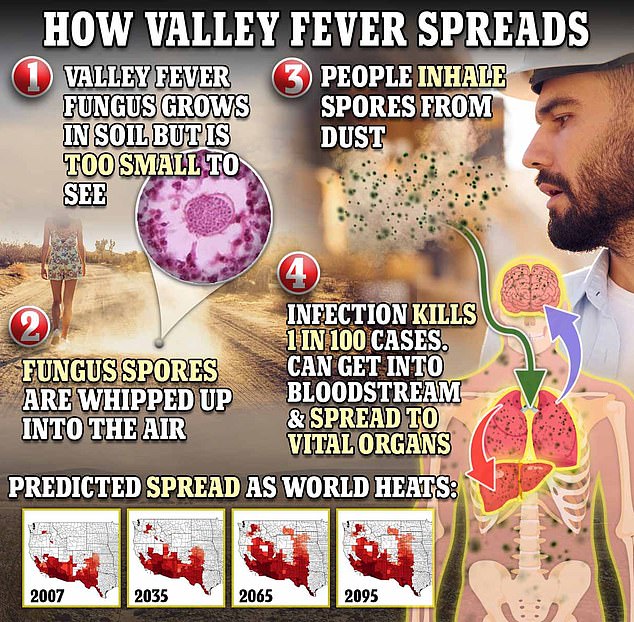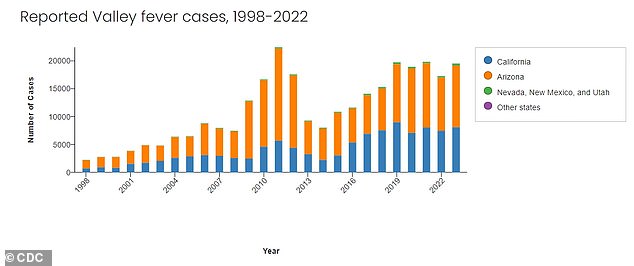Thousands of people attending a popular music festival in California have been warned they may have been exposed to a potentially deadly fungus.
The California Department of Public Health (CDPH) saying The agency is investigating a cluster of Valley Fever cases identified among attendees of the Lightning in a Bottle music festival in Buena Vista Lake, which ran from May 21 to 25.
More than 20,000 people attended the event and five of them were diagnosed with Valley Fever. Three of those infected were hospitalized.
Valley fever, so named because most cases occur in Arizona and California, is a deadly infection that kills one in every 100 people who contract it.
The above shows the number of Valley Fever cases reported in the US from 1998 to 2023.

The above shows areas where the fungus that causes Valley Fever could be present.
It is caused by the fungus Coccidioides, which releases spores into the air when soil is disturbed and which are then inhaled by people. There is no person-to-person transmission.
The CDPH said: ‘There may be additional cases related to attendance at the outdoor festival.’
The department added: “Overall, Valley fever cases in California have increased substantially over the past two years, so CDPH is asking festival-goers to complete a voluntary survey, even if they do not have any symptoms.”
Officials have not released any information about the patients, but one Reddit user claims to be one.
About 18 days after returning from the festival, they were hospitalized with a severe lung infection and experienced fever, aches and cough.
The user said Valley fever was “no joke” and was “causing a cavity (a hole) to form inside my right lung.”
Another user commented on the post saying that he too had contracted Valley fever and was “incredibly sick.”
A sign said her husband had become infected and developed fluid in his chest and around his lungs. His symptoms began on June 5 and he was hospitalized on June 12. He was eventually sent home on July 1, but will need to receive antifungal treatments “for months.”
Several users said the festival organizers should relocate in the future due to the prevalence of the fungus in the area and the dusty conditions of the event.
Most people with mild Valley fever won’t realize they have the disease because its symptoms (fatigue, cough, fever, muscle aches, and shortness of breath) mimic those of a respiratory viral infection.
Other symptoms include night sweats, joint pain, and a red rash, usually on the legs but occasionally on the chest, arms, and back.
The disease, for which there is no preventive vaccine, can often be overlooked by doctors or misdiagnosed as pneumonia.
But up to 10 percent of infections become severe and take months to recover.
In these cases, known as disseminated coccidioidomycosis, the disease can spread through the bloodstream to other parts of the body, including the brain, skin, and liver.
If it infects the membranes and fluid surrounding the brain, it can cause life-threatening meningitis.
There is no proven treatment for Valley Fever and patients are generally prescribed rest and given therapies to control symptoms.
Doctors may prescribe antifungal medications, but there is no evidence from clinical trials to show that these treatments are effective, and antifungal medications have the potential to cause serious side effects.

Valley fever is caused by the fungus Coccidioides, which releases spores into the air when soil is disturbed, which are then inhaled by people.
California health officials are encouraging people who visited the area around the festival, near the city of Bakersfield and in Kern County, and are experiencing respiratory symptoms to visit a doctor and ask if they can be tested for Valley fever.
The department said: ‘Be sure to mention attending the music festival or traveling to Kern County, where Valley fever is common.’
Although only five cases have been detected, there are likely to be more.
Mild cases of the fungus in people who contracted it at the event two months ago may have already resolved and others still experiencing symptoms may still be undiagnosed.
The number of Valley fever cases peaked for the first time in a decade in 2021. The 20,970 cases reported were the most in a single year since the last peak in 2011.
Cases declined in 2022, but rose again last year and Experts are concerned about the predicted increase in the fungus in the coming decades.
The CDC estimates that Valley fever could infect more than half a million Americans each year in the future.
The agency said that because of rising temperatures around the world, the disease’s endemic region will spread northward to include dry areas in the West. Other experts fear it could be endemic in 17 states by 2100.

